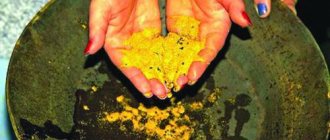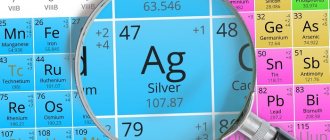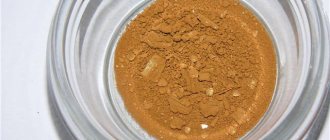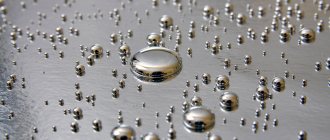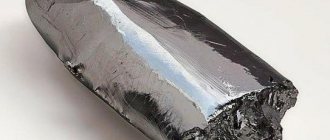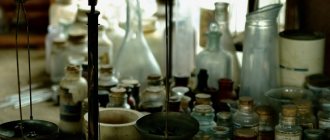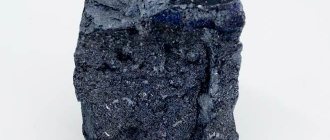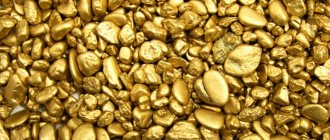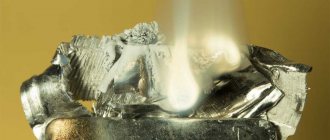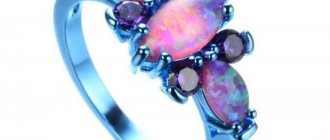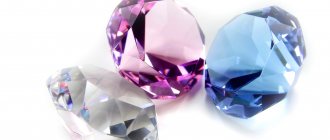Gold (Au, from the Latin Aurum) is a chemical element that is in Group I of the Periodic Table and is included in the group of noble metals. In addition to gold, this group also includes silver, platinum, ruthenium, rhodium, palladium, osmium, iridium and sometimes rhenium. The above metals received this name due to their high chemical resistance. Gold has been highly valued all over the world since ancient times. Its special value is evidenced by the fact that any medieval alchemist considered the goal of his life to obtain gold from other substances, most often mercury was used as the starting material. There are legends that some, such as Nicolas Flamel, even succeeded.
Being in nature
Gold is everywhere. A cubic kilometer of sea water contains 5 kg of the coveted element, and if you prick your finger and squeeze out a drop of blood, it will contain 0.00025 mg of gold. 10 mg is contained in the human skeleton: if you set out to melt a ring of people, you will only need 300 people. But this gold is in such a dispersed form in the environment that it is unprofitable and often impossible to extract it from there.
Deposits suitable for gold mining are divided into primary - primary (post-magmatic) and secondary (placer).
Primary deposits
Magma, the melt inside the globe, is rich in the chemical element Au. Gold is found in the upper layers of the mantle and partially in the earth's crust (however, it contains almost the entire periodic table). Magma comes to the surface of the planet, cools and turns into solid rock. The places where it contains enough of the precious element to justify industrial development are primary deposits.
Natural gold is found in the form of nuggets - whole grains of a chemically pure substance. It is often combined with other elements (magma contains almost everything):
- silver;
- copper;
- platinum group metals;
- bismuth and others.
Secondary deposits
Secondary deposits are the result of the destruction of primary ones, the so-called weathering, which happens:
- physical (cause - wind, water, temperature fluctuations);
- chemical (chemical reactions);
- biological (bacteria and other organisms).
A placer of pure gold looks like sand and sometimes drifts along waters many kilometers from the original deposit.
History of element discovery
In its pure form, gold fell into the hands of man in the 6th century BC. Massive development of African deposits began earlier - around 2000 BC. e., but there were no methods for getting rid of impurities, and gold products of that time are of low standard.
During late antiquity (beginning of our era), alchemy began to spread throughout the world with its desire to transform base chemical elements into noble ones. She was not successful, but thanks to her, modern civilization has mastered many miracles - for example, the technique of extracting chemically pure gold from ore.
The Latin name for gold is Aurum (read as aurum) - “yellow”. It is accepted as international. The symbol of the sun among alchemists looked like a circle with a dot inside, and in modern chemistry it is denoted by the abbreviation Au.
How do you get it?
The main methods for producing gold on an industrial scale complement each other - for example, concentrate can be purified from dense impurities by amalgamation.
Flushing
Washing (sizing) is an ancient method of extracting gold sand (size) from secondary deposits. Sand is washed away due to its density: less dense minerals are washed out with water, and the concentrate settles.
Large-scale gold mining is automated: instead of people, washing devices and excavators work. However, the principle of their operation has remained almost unchanged over the past 2000 years.
The concentrate is not pure gold. There are elements that are denser - they settle with sand at the bottom of the washing tank. For final cleaning, other methods, in particular chemical ones, are used.
Amalgamation
This method has also been known since antiquity, but was described in the 16th century. It is possible due to the property of mercury to form alloys (amalgams) with other metals without additional thermal or chemical effects. After getting rid of waste rock fragments, the chemical elements are mechanically separated.
Expert opinion
Vsevolod Kozlovsky
6 years in jewelry making. Knows everything about samples and can identify a fake in 12 seconds
Amalgamation is not used everywhere: in a number of countries (since 1988 - in Russia) the use of mercury is prohibited due to the deadly danger of this element to humans.
Cyanidation
The method of extracting a precious element from ore by cyanidation is based on the ability of gold to dissolve in hydrocyanic acid (hydrogen cyanide, HCN) and its salts. The ore is treated with a weak (0.03–0.3%) cyanide solution. The noble metal reacts before other chemical elements, and after the chemical reaction it precipitates from solution.
Physical parameters of the metal
From a physics point of view, gold also has many advantages over other metals. Pure gold has a bright yellow rich color. If the product has a tint, ask what is included in the ligature. The addition of copper gives a reddish tint, silver or other white metal in the alloy creates white gold. In nature, in a gold deposit, you can see a precious metal with a green tint, depending on the amount of ore included in the composition.
In terms of hardness, gold is considered a soft metal. The scale with criteria is named after Mohs, and the hardest substance on earth is considered to be diamond. It was assigned the number 10. For gold, this figure is 2.5-3.0. This is because pure gold can easily be cut with a knife or even just scratched. It is because of this that jewelers do not want to make jewelry from 999 fineness, since it is short-lived and the product will need to be additionally covered with protective layers on top.
To determine the hardness of a metal in the field, it is enough to scratch it with a sharp object. If a trace remains, then the hardness is below 5. This is also how the authenticity of coins was checked in the old days. They were simply bitten, and if traces remained on the money, this means that the coins were real.
Gold can splinter and scatter, as well as wear off. Therefore, coins made of pure precious metal quickly failed and became unsuitable for trade. The metal is easy to polish and can be used as a light reflector.
The metal has high malleability, ductility and ductility. It is thanks to these properties that jewelry and products of various shapes are made from gold. It is even possible to roll out thin sheets of metal. This type of gold is called leaf and is used to cover icons and interior items.
Metal is used to create very small chips in microcircuits. In addition, in addition to being malleable, gold conducts electricity well, and the contacts do not move away from each other over time. Gold can be melted at a temperature of 1063 degrees Celsius, and boiled at 2947 degrees Celsius. During these processes, the metal will lose its color and turn pale green.
The property of the metal, its density, helps gold miners. It is 19.3 times greater for gold than for water. Therefore, gold particles settle at the bottom of running water, and they are also easy to rinse and remove impurities.
Gold's place in Mendeleev's periodic table
The element is located in group XI (copper subgroup), period VI of the periodic table of chemical elements.
The atomic number (charge number) of gold is 79. This is the number of protons in the nucleus of an atom, equal to the number of electrons orbiting the nucleus. The atomic mass - the total mass of protons and neutrons (atomic nucleus) - of gold is 196.9665 amu. (atomic mass units). Natural gold exists in the form of the chemically stable isotope 197 Au. All others are unstable and are possible only in a nuclear reactor.
Formula
Gold does not have its own chemical formula, since it exists in the form of monatomic molecules. The electronic configuration of the Au atom is written as [Xe] 4f14 5d10 6s1 and denotes the exact distribution of electrons among the orbitals.
Interaction with acids
Due to its inertness (not absolute, but significant), gold does not dissolve in acids. This allows them to be used for refining (chemical purification of an element from impurities): the alloy is treated with an acid, such as nitric acid, and thus gets rid of the alloy.
But there are exceptions. Pure gold is dissolved by acids:
- selenium;
- cyanide and its salts (cyanides);
- nitrogen mixed with hydrochloric water (regia vodka).
Oxidation states and relationships with halogens
Under natural conditions, Au does not oxidize when exposed to oxygen - this is one of the properties that makes the element precious. When heated, gold reacts with halogens (elements of group XVII): iodine, fluorine, bromine and chlorine, forming iodide, fluoride, bromide and chloride, respectively.
Standard oxidation states are 1 and 3. Fluoride with an oxidation state of +5 has been isolated in laboratory conditions.
Measures of gold purity
States control the circulation of precious metals. A century ago, almost every country had its own testing system, but now most have been brought to a common denominator.
British carat system
In the carat system (USA, Canada, Switzerland), the number 24 is accepted as 100%. The mark “18 K” indicates that the jewelry consists of 75% of precious metal, and 25% of something else - for example, copper and palladium .
Metric system
In Russia, the CIS, and Germany, the number on the stamp is the number of ppm (thousandths) of gold in the alloy. 500 ‰ - sample 500, 375 ‰ -375. Only the 1000 sample does not exist - instead there is 999.9. It contains a microscopic amount of impurities and is conventionally considered pure.
Spool system
The spool sampling system operated in the Russian Empire, the RSFSR and the USSR in 1798–1927. It is based on the Russian pound, equal to 96 spools, similar to the carat mathematically, but divides the whole not into 24, but into 96 shares.
Sample correspondence table
Let's look at the three systems in comparison. There is also a lot sample - it essentially repeats the carat sample, but takes 16 units (lot) for one hundred percent. The lot hallmark was used to hallmark silver in Europe before the introduction of the metric system and has no relation to gold.
| Metric system | 999 | 958 | 916 | 900 | 750 | 585 | 500 | 375 |
| Carat sample system | 24 | 23 | 22 | 21,6 | 18 | 14 | 12 | 9 |
| Spool sampling system | 96 | 92 | 88 | 86,4 | 72 | 56 | 48 | 36 |
Areas of application
Gold has long been used by various countries in the form of coins. However, they were approved as a monopoly monetary instrument only in the 19th century.
Today, the precious metal is used in many areas of society:
- Jewelry industry. It is this area that accounts for a large volume of mined rock. Jewelry and accessories are made not from pure substance, but from its alloys with other metals, which increase the mechanical strength and durability of the products. Usually gold is combined with silver and copper. Additional components include zinc, cobalt, nickel or palladium. The precious metal determines the resistance of the alloy to corrosion, the ratio of copper and silver determines the shade and mechanical features. An important characteristic of such products is sample. It is determined by the gold content in them.
- Industry. The substance is used for electrical contacts. Microelectronics cannot do without gold conductors and electroplated metal coatings. Treating window glass with this material can reduce heat loss in winter and protect rooms from heating by ultraviolet rays in summer. Gold solders are used to moisten surfaces of various metals. The substance is used to protect against corrosion and give other materials an expensive look.
- Dentistry. Gold alloys are used to produce crowns and dentures that do not deteriorate.
- Pharmacology. The substance often serves as an additional component in medications for tuberculosis and rheumatoid arthritis. The radioactive isotope, designated 198Au, is used to treat malignant tumors. Before using drugs, you need to make sure that the patient does not have negative reactions to gold.
- Food industry. The element as a food additive E175 is used to decorate various dishes.
At all times, gold has served as an important element of the financial system. This metal is not susceptible to corrosion, so they are trying to find application in various fields. The metal's role as an international currency has periodically declined, but banks in all countries hold it as the most important source of liquidity.
How to spot a fake
To make money by passing off products made from base alloys as valuable, scammers resort to tricks: burning silver on fire, combining copper with zinc and tin. Pay attention to:
- Brand - it must meet the standard.
- Price - if it is incredibly low, this is an alarming sign.
- Country of origin - check the jewelry again if it is Turkey, China or the UAE.
There are tips to try something on your teeth in front of the seller or test it chemically by dropping iodine on it. These are effective methods for determining the authenticity of high standards, but they are not always acceptable in society. If the seller makes you doubt so much that you are ready to bite his goods, you should refuse the purchase.
Other colors
Modern technologies make it possible to create gold alloys of almost any shade, but not all of them have sufficient characteristics to enter the wide market. So, there are several technologies for inventing purple gold. But such products are not always practical.
In Uralsk, scientists at the Physical Institute of Metals have come up with a way to create green, purple, blue, violet and black gold.
In addition, scientists have discovered the fact that when certain conditions are compared, the surface of gold can acquire different shades. By experimenting with yellow gold, it was possible to achieve a deep blue tint of the alloy.
